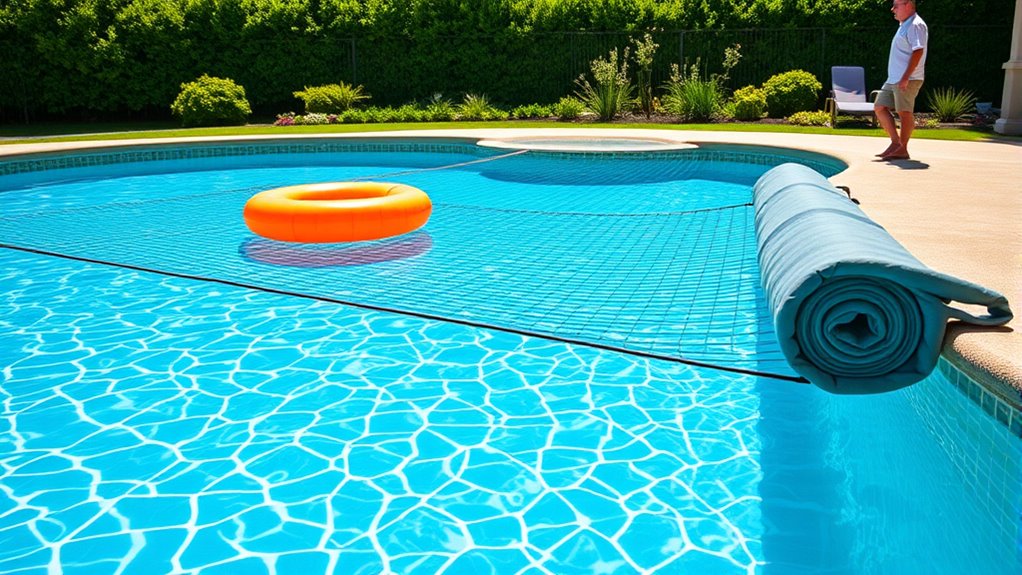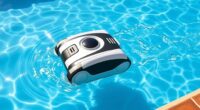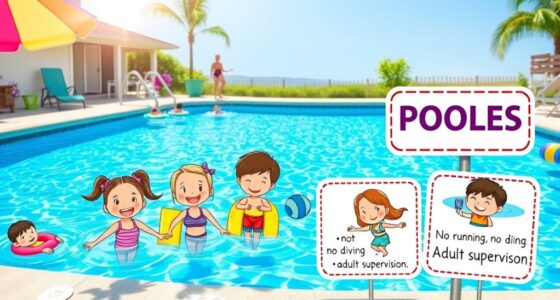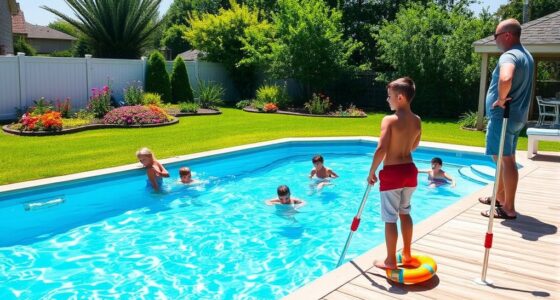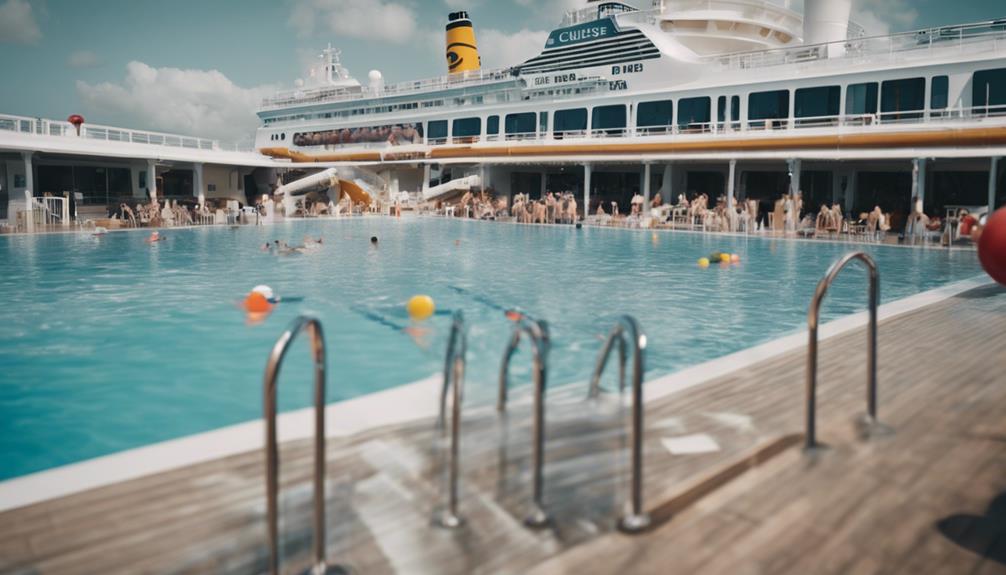To prevent drowning, you should use lifesaving gadgets like pool alarms, floatation devices, and rescue hooks, and ensure they are maintained and functioning properly. Installing proper fencing with self-closing, self-latching gates, along with alarms on access points, enhances safety. Always supervise swimmers, especially children, and teach water safety rules. Combining these steps with legal compliance creates a layered safety system that markedly reduces risks—keep exploring to learn more about keeping your pool safe.
Key Takeaways
- Install and regularly maintain safety gadgets like alarms, floatation devices, and rescue hooks to ensure immediate response during emergencies.
- Enforce pool safety laws, including fencing with self-closing gates and alarms on access points, to restrict unauthorized entry.
- Supervise children constantly and educate all pool users about safety rules and emergency procedures.
- Use safety covers and ensure all equipment is functional and accessible for quick rescue when needed.
- Continuously review safety protocols, keep equipment in good condition, and promote awareness to prevent drowning incidents.

Have you ever wondered how to keep yourself and loved ones safe around water? As a pool owner, it’s essential to understand that safety isn’t just about having fun—it’s about preventing tragedies. One of the most effective ways to do this is by using lifesaving gadgets. Devices like pool alarms, floatation devices, and rescue hooks can make all the difference in an emergency. Pool alarms, for example, alert you instantly if someone enters the water unexpectedly, giving you precious seconds to respond. Floatation devices, such as life jackets or pool noodles, provide added safety for weaker swimmers or small children, offering peace of mind. Rescue hooks or reaching poles are also vital—they enable you to assist someone in distress without putting yourself in danger. Combining these gadgets with vigilant supervision creates a layered safety approach that considerably reduces the risk of drowning.
However, simply having lifesaving gadgets isn’t enough. You also need to understand and follow your local pool safety laws. These laws are designed to establish minimum safety standards and protect everyone around the water. They often require pool fencing that completely encloses the pool area with a self-closing, self-latching gate to prevent unauthorized or accidental access. Many jurisdictions also mandate the installation of alarms on gates or doors leading to the pool area. Other laws might specify the minimum number of adult supervisors needed when children are present or require that pools be covered or equipped with safety covers when not in use. Familiarizing yourself with these regulations ensures you’re compliant and, more importantly, that you’re doing everything possible to create a safe environment. Ignorance of pool safety laws can lead to fines and, more critically, preventable accidents. Recognizing the importance of dreams and subconscious signals can also help in understanding and addressing potential emotional fears related to safety and security around water.
It’s also wise to regularly review and update your safety measures. Confirm your lifesaving gadgets are in good working order, and replace or repair any faulty equipment immediately. Educate everyone who uses your pool—family, friends, or visitors—about pool safety rules and emergency procedures. This includes teaching children how to swim, emphasizing the importance of never swimming alone, and always supervising young swimmers. Remember, safety is a continuous process that involves awareness and proactive measures. By combining lifesaving gadgets, adhering to pool safety laws, and maintaining vigilant supervision, you create a safer environment where everyone can enjoy the water without fear. Taking these steps isn’t just about compliance—it’s about caring for those you love and preventing the devastating effects of drowning.
Frequently Asked Questions
How Effective Are Pool Alarms in Preventing Drownings?
Pool alarm effectiveness varies, but they can be a valuable part of drowning prevention technology. You should know that alarms alert you immediately if someone enters the pool unexpectedly, helping prevent accidents. While they aren’t foolproof and shouldn’t replace constant supervision, adding a reliable pool alarm enhances your safety measures. Using pool alarms along with barriers and vigilant supervision creates a layered approach, substantially reducing drowning risks for everyone around your pool.
What Are the Legal Requirements for Pool Fencing in My Area?
You need to check your local regulations to guarantee legal compliance for pool fencing. Fencing regulations typically require a barrier at least four feet high, with a self-closing, self-latching gate to prevent unauthorized access. These rules are designed to keep children safe and prevent accidents. Make sure your fencing meets all local codes, as non-compliance could lead to fines or liability issues. Always verify with your local authorities for specific requirements.
How Often Should Pool Safety Equipment Be Inspected?
You should inspect your pool safety equipment regularly, ideally monthly, as part of your pool maintenance routine. Check safety signage for visibility and clarity, confirm safety devices like life rings and alarms are functional, and replace any worn or damaged items promptly. Regular inspections help you identify potential hazards early, keeping everyone safe. Staying proactive with safety signage and equipment maintenance minimizes risks and promotes a safer swimming environment for all.
Are There Specific Safety Tips for Supervising Children Around Pools?
Imagine your pool as a sparkling oasis, but even paradise needs guardians. You must prioritize child supervision and stay alert with poolside vigilance, never leaving kids unattended. Keep children within arm’s reach, enforce rules, and remove toys when not in use. Establish clear boundaries, and always stay focused—your attentive eye is the key to keeping little swimmers safe, turning your pool into a secure haven rather than a hidden hazard.
What Are the Best Rescue Techniques for Drowning Emergencies?
In a drowning emergency, you should act quickly by calling for help and removing the person from the water. Use rescue breathing if they’re unresponsive and not breathing, following lifeguard training guidelines. Keep their head tilted back to open the airway, and give steady breaths until help arrives. Remember, staying calm and acting confidently can make all the difference in saving someone’s life.
Conclusion
Remember, as a pool owner, your vigilance can save lives. Did you know that drowning is the leading cause of accidental death among children under five? By practicing constant supervision, installing barriers, and learning CPR, you profoundly reduce these risks. Stay proactive and informed—your quick actions can make all the difference. Keep safety at the forefront, and enjoy your pool responsibly, knowing you’ve taken steps to protect your loved ones from harm.

